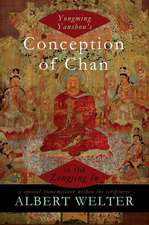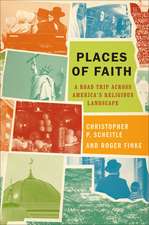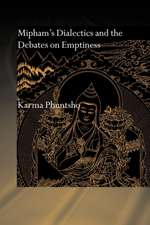Reforming the Art of Dying: The ars moriendi in the German Reformation (1519–1528): St Andrews Studies in Reformation History
Autor Austra Reinisen Limba Engleză Hardback – 22 feb 2007
Din seria St Andrews Studies in Reformation History
- 15%
 Preț: 695.67 lei
Preț: 695.67 lei -
 Preț: 311.51 lei
Preț: 311.51 lei -
 Preț: 296.35 lei
Preț: 296.35 lei -
 Preț: 313.38 lei
Preț: 313.38 lei - 23%
 Preț: 942.83 lei
Preț: 942.83 lei - 30%
 Preț: 772.07 lei
Preț: 772.07 lei - 18%
 Preț: 1054.71 lei
Preț: 1054.71 lei - 18%
 Preț: 1000.27 lei
Preț: 1000.27 lei - 30%
 Preț: 768.30 lei
Preț: 768.30 lei - 17%
 Preț: 240.92 lei
Preț: 240.92 lei - 26%
 Preț: 822.34 lei
Preț: 822.34 lei - 18%
 Preț: 1000.27 lei
Preț: 1000.27 lei - 30%
 Preț: 783.79 lei
Preț: 783.79 lei - 31%
 Preț: 766.66 lei
Preț: 766.66 lei - 18%
 Preț: 1000.27 lei
Preț: 1000.27 lei - 28%
 Preț: 498.88 lei
Preț: 498.88 lei - 18%
 Preț: 1053.16 lei
Preț: 1053.16 lei - 31%
 Preț: 767.88 lei
Preț: 767.88 lei - 18%
 Preț: 1054.71 lei
Preț: 1054.71 lei - 31%
 Preț: 764.87 lei
Preț: 764.87 lei - 18%
 Preț: 1062.62 lei
Preț: 1062.62 lei - 18%
 Preț: 1005.01 lei
Preț: 1005.01 lei - 30%
 Preț: 768.82 lei
Preț: 768.82 lei - 31%
 Preț: 765.19 lei
Preț: 765.19 lei - 18%
 Preț: 1062.62 lei
Preț: 1062.62 lei - 31%
 Preț: 764.20 lei
Preț: 764.20 lei - 30%
 Preț: 769.55 lei
Preț: 769.55 lei - 25%
 Preț: 768.30 lei
Preț: 768.30 lei - 30%
 Preț: 770.33 lei
Preț: 770.33 lei -
 Preț: 349.80 lei
Preț: 349.80 lei - 31%
 Preț: 765.84 lei
Preț: 765.84 lei - 31%
 Preț: 765.84 lei
Preț: 765.84 lei - 18%
 Preț: 1004.20 lei
Preț: 1004.20 lei - 27%
 Preț: 496.94 lei
Preț: 496.94 lei - 18%
 Preț: 1001.84 lei
Preț: 1001.84 lei - 30%
 Preț: 770.62 lei
Preț: 770.62 lei - 28%
 Preț: 739.65 lei
Preț: 739.65 lei - 30%
 Preț: 772.76 lei
Preț: 772.76 lei - 31%
 Preț: 767.47 lei
Preț: 767.47 lei - 18%
 Preț: 1063.89 lei
Preț: 1063.89 lei - 18%
 Preț: 1057.09 lei
Preț: 1057.09 lei - 31%
 Preț: 765.01 lei
Preț: 765.01 lei - 31%
 Preț: 764.20 lei
Preț: 764.20 lei - 18%
 Preț: 1005.04 lei
Preț: 1005.04 lei - 30%
 Preț: 768.46 lei
Preț: 768.46 lei - 31%
 Preț: 763.39 lei
Preț: 763.39 lei -
 Preț: 376.48 lei
Preț: 376.48 lei
Preț: 880.05 lei
Preț vechi: 1218.47 lei
-28% Nou
Puncte Express: 1320
Preț estimativ în valută:
168.42€ • 182.88$ • 141.47£
168.42€ • 182.88$ • 141.47£
Carte tipărită la comandă
Livrare economică 22 aprilie-06 mai
Preluare comenzi: 021 569.72.76
Specificații
ISBN-13: 9780754654391
ISBN-10: 0754654397
Pagini: 304
Dimensiuni: 156 x 234 x 19 mm
Greutate: 0.7 kg
Ediția:1
Editura: Taylor & Francis
Colecția Routledge
Seria St Andrews Studies in Reformation History
Locul publicării:Oxford, United Kingdom
ISBN-10: 0754654397
Pagini: 304
Dimensiuni: 156 x 234 x 19 mm
Greutate: 0.7 kg
Ediția:1
Editura: Taylor & Francis
Colecția Routledge
Seria St Andrews Studies in Reformation History
Locul publicării:Oxford, United Kingdom
Cuprins
Contents: Preface; Introduction; Between fear and hope: uncertainty of salvation in the late medieval Ars moriendi; Martin Luther’s Eyn Sermon von der bereytung zum sterben (1519); Sermons on preparation for death; Handbooks or manuals for use at the deathbed; Instruction on dying in summaries of reformation teaching; Conclusion; Bibliography; Index.
Recenzii
’The work fills a gap in the understanding of how a particular area of pastoral care and instruction took on a Reformed shape.’ Anaphora ’... clearly-written and thorough review of a neglected by important genre... a useful study that makes accessible to an English-speaking readership a genre which continued to be of great pastoral significance throughout the years of the early Lutheran Reformation and beyond.’ Ecclesiastical History ’This is a richly documented theological and rhetorical analysis, buttressed by interesting details about biographical and social context, that effectively represents the enthusiasm of these early evangelical theologians of consolation at death.’ Catholic Historical Review ’This is a useful book for both specialists and nonspecialists.’ German Studies Review
Notă biografică
Austra Reinis is Assistant Professor of the History of Christianity in the Department of Religious Studies, Missouri State University, Springfield, Missouri, USA.
Descriere
This study focuses on the earliest of Protestant handbooks that addressed the subject of death and dying. Beginning with Luther's Sermon on Preparing to Die in 1519 and ending with Jakob Otter's Christlich leben vnd sterben in 1528, it explores how Luther and his colleagues adopted traditional themes and motifs, transforming them to accord with their conviction that Christians could be certain of their salvation. It further shows how Luther's colleagues drew on his writings, not only his teaching on dying, but also other writings including his sermons on the sacraments. The study concludes that the assurance of salvation that these works offered represented a significant change from traditional teaching on death.











